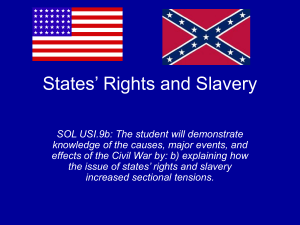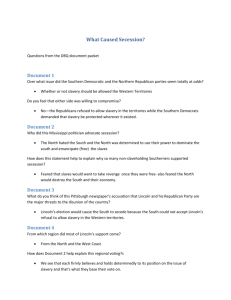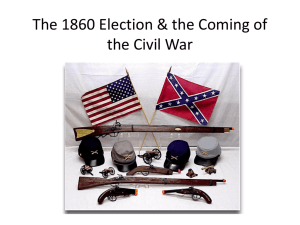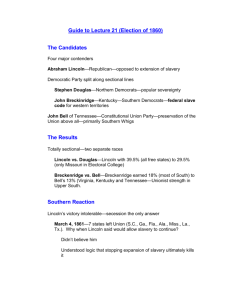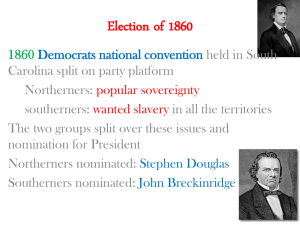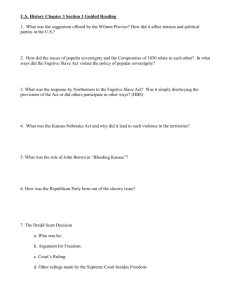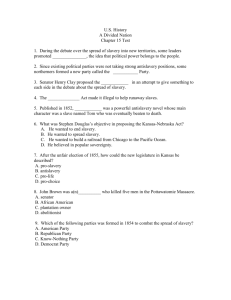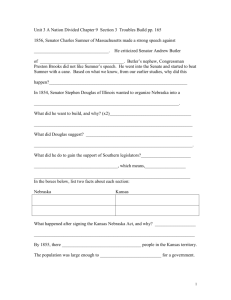Lincoln's Election and Southern Secession
advertisement
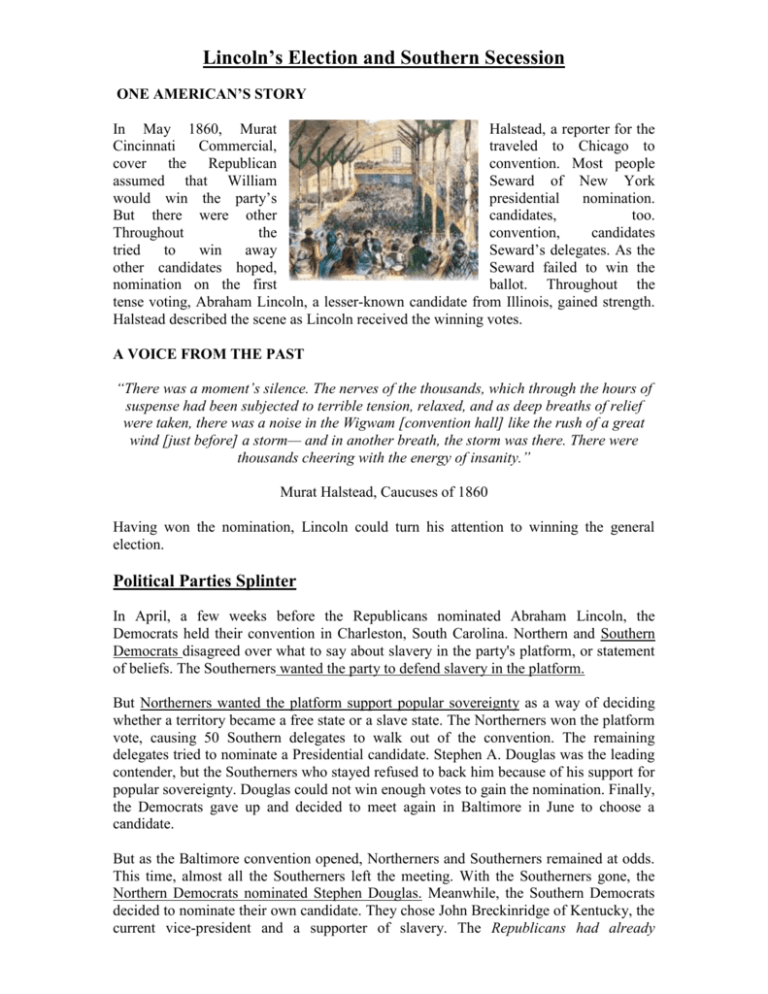
Lincoln’s Election and Southern Secession ONE AMERICAN’S STORY In May 1860, Murat Halstead, a reporter for the Cincinnati Commercial, traveled to Chicago to cover the Republican convention. Most people assumed that William Seward of New York would win the party’s presidential nomination. But there were other candidates, too. Throughout the convention, candidates tried to win away Seward’s delegates. As the other candidates hoped, Seward failed to win the nomination on the first ballot. Throughout the tense voting, Abraham Lincoln, a lesser-known candidate from Illinois, gained strength. Halstead described the scene as Lincoln received the winning votes. A VOICE FROM THE PAST “There was a moment’s silence. The nerves of the thousands, which through the hours of suspense had been subjected to terrible tension, relaxed, and as deep breaths of relief were taken, there was a noise in the Wigwam [convention hall] like the rush of a great wind [just before] a storm— and in another breath, the storm was there. There were thousands cheering with the energy of insanity.” Murat Halstead, Caucuses of 1860 Having won the nomination, Lincoln could turn his attention to winning the general election. Political Parties Splinter In April, a few weeks before the Republicans nominated Abraham Lincoln, the Democrats held their convention in Charleston, South Carolina. Northern and Southern Democrats disagreed over what to say about slavery in the party's platform, or statement of beliefs. The Southerners wanted the party to defend slavery in the platform. But Northerners wanted the platform support popular sovereignty as a way of deciding whether a territory became a free state or a slave state. The Northerners won the platform vote, causing 50 Southern delegates to walk out of the convention. The remaining delegates tried to nominate a Presidential candidate. Stephen A. Douglas was the leading contender, but the Southerners who stayed refused to back him because of his support for popular sovereignty. Douglas could not win enough votes to gain the nomination. Finally, the Democrats gave up and decided to meet again in Baltimore in June to choose a candidate. But as the Baltimore convention opened, Northerners and Southerners remained at odds. This time, almost all the Southerners left the meeting. With the Southerners gone, the Northern Democrats nominated Stephen Douglas. Meanwhile, the Southern Democrats decided to nominate their own candidate. They chose John Breckinridge of Kentucky, the current vice-president and a supporter of slavery. The Republicans had already nominated Abraham Lincoln. In addition to Lincoln, Douglas, and Breckinridge, a candidate from a fourth party entered the race. This party was called the Constitutional Union Party, and its members had one aim to preserve the Union. They nominated John Bell of Tennessee to run for president. The Election of 1860 The election of 1860 turned into two different races for the presidency, one in the North and one in the South. Lincoln and Douglas were the only candidates with much support in the North. Breckinridge and Bell competed for Southern votes. Lincoln and Breckinridge were considered to have the most extreme views on slavery. Lincoln opposed the expansion of slavery into the territories. Breckinridge insisted that the federal government be required to protect slavery in any territory. Douglas and Bell were considered moderates because neither wanted the Federal government to pass new laws on slavery. The outcome of the election made it clear that the nation was tired of compromise. Lincoln defeated Douglas in the North. Breckinridge carried most of the South. Douglas and Bell managed to win only in the states between the North and the Deep South. Because the North had more people in it than the South, Lincoln won the election. Despite Lincoln’s statements that he would do nothing to abolish slavery in the South, white Southerners did not trust him. Many were sure that he and the other Republicans would move to ban slavery. As a result, white Southerners saw the Republican victory as a threat to the Southern way of life. Southern States Secede Before the 1860 presidential election, many Southerners had warned that if Lincoln won, the Southern states would secede or withdraw from the Union. Supporters of secession based their arguments on the idea of states' rights. They argued, "The states had 2 voluntarily joined the Union. Consequently, they claimed that the states also had the right to leave the Union. On December 20, 1860, South Carolina became the first state to secede. Other states in the Deep South, where slave labor and cotton production were most common, also considered secession. During the next six weeks, Mississippi, Florida, Alabama, Georgia, Louisiana, and Texas joined South Carolina in secession. In early February 1861, the states that had seceded met in Montgomery, Alabama. They formed the Confederate States of America. The convention named Jefferson Davis president of the Confederacy. Along with naming Davis president, the convention drafted a constitution. The Confederate Constitution was modeled on the U.S. Constitution, but there were a few important differences. For example, the Confederate Constitution supported states rights. It also protected slavery in the Confederacy, including any territories it might acquire. Having formed its government, the Confederate states made plans to defend their separation from the Union. Some believed that War Between the States could not be avoided. But everyone waited to see what the Union government would do in response. The Union Responds to Secession Northerners considered the secession of the Southern states to be unconstitutional. During his last months in office, President James Buchanan argued against secession. He believed that the states did not have the right to withdraw from the Union because the federal government, not the state governments, was sovereign. If secession were permitted, the Union would become weak, like a "rope of sand." He believed that the U.S. Constitution was framed to prevent such a thing from happening. In addition to these issues, secession raised the issue of majority rule. Southerners complained that Northerners intended to use their majority to force the South to abolish slavery. But Northerners responded that Southerners simply did not want to live by the rules of democracy. They complained that Southerners were not willing to live with the election results. As Northern writer James Russell Lowell wrote, "[The Southerners'] quarrel is not with the Republican Party, but with the theory of Democracy." Efforts to Compromise Fail With the states in the lower South forming a new government in Montgomery, Alabama, some people continued to seek compromise. Senator John J. Crittenden of Kentucky developed a compromise plan. The Crittenden Plan was presented to Congress in late February 1861, but it did not pass. With the hopes for compromise fading, Americans waited for Lincoln's inauguration. What would the new president do about the crisis? On March 4, Lincoln took the oath of office and gave his First Inaugural Address. He assured the South that he had no intention of abolishing slavery there. But he spoke forcefully against secession. Then he ended his speech with an appeal to friendship. 3 A VOICE FROM THE PAST “We are not enemies, but friends. We must not be enemies. Though passion may have strained, it must not break our bonds of affection. The mystic chords of memory, stretching from every battle-field and patriot grave, to every living heart and hearthstone, allover this broad land will yet swell the chorus of the Union, when again touched, as surely they will be, by the better angels of our nature.” Abraham Lincoln First Inaugural Address 4
